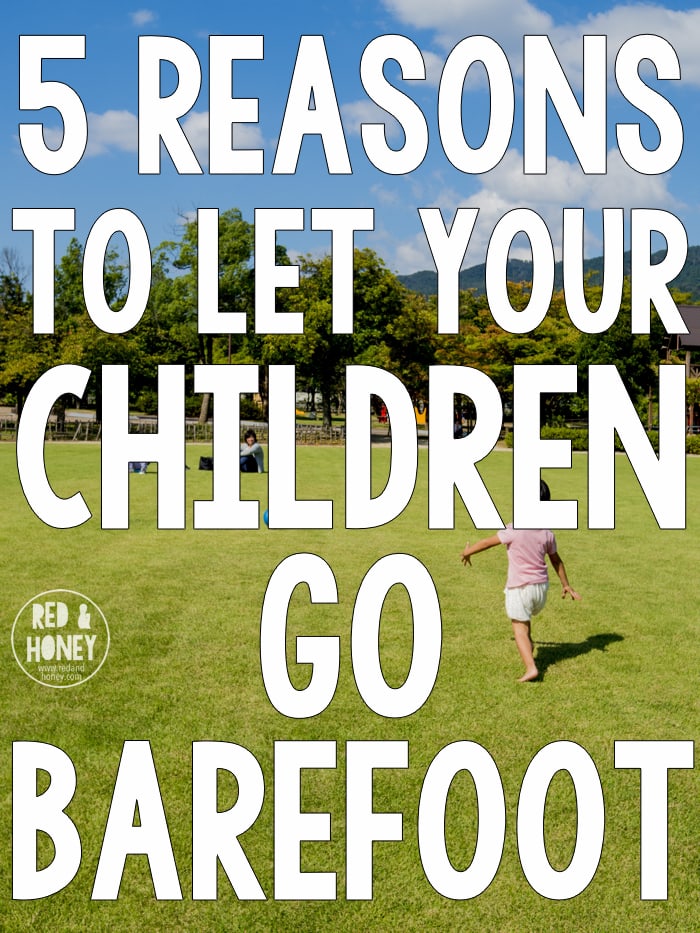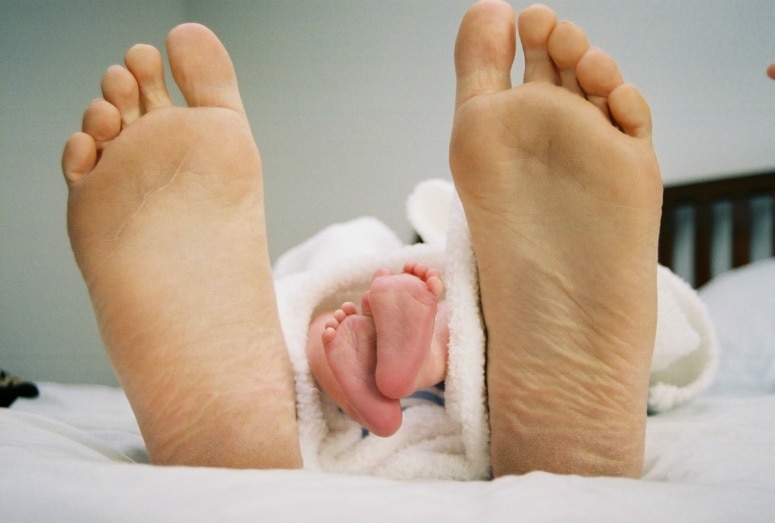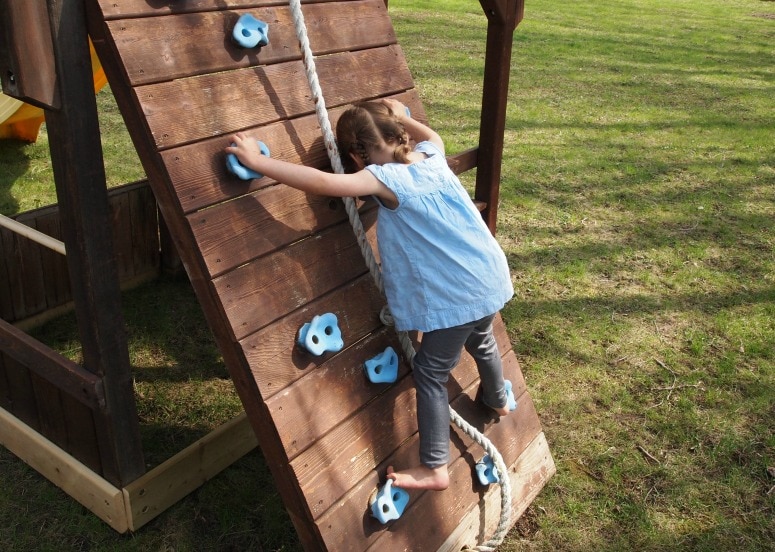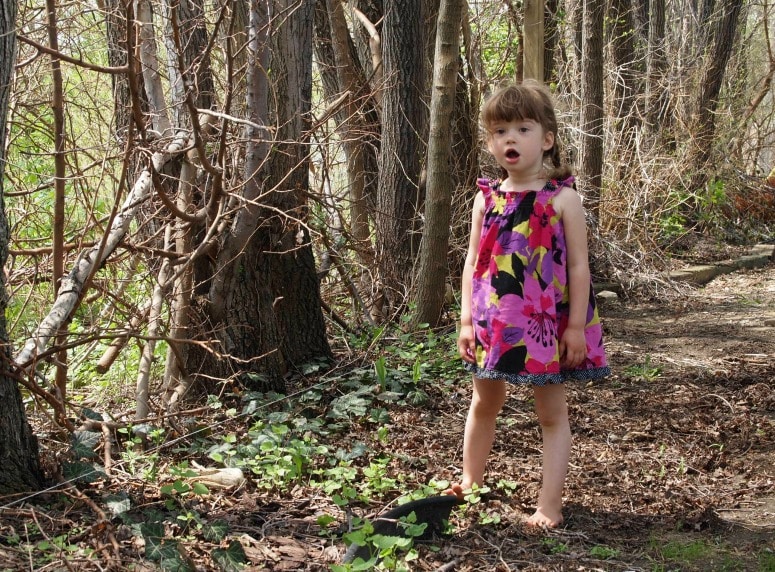
Walking barefoot through the warm summer grass. Who doesn’t feel a bit nostalgic remembering the childhood pleasure of going around barefoot? Almost anyone would agree that it’s enjoyable to kick off one’s shoes every once in a while and feel the earth beneath your feet.
But did you know there are lots of good reasons to encourage your child to go barefoot? Not just occasionally, but as often as possible?
It’s good for all of us, but little ones — whose bodies are growing rapidly — can especially benefit from going without shoes.
Now that the weather’s warmer, I encourage my three-year-old daughter to be barefoot pretty much all the time, as I am. We keep a pair of sandals for each of us in the van, to slip on before entering a store or restaurant (It can be annoying to get hassled by a store manager for being barefoot).
Otherwise, we’re almost always completely unshod, weather permitting.
Here are 5 reasons I try to keep shoes off my little one:
1. To Allow Feet to Grow and Develop the Way They Were Meant To
You may never have noticed this, but shoes actually change the shape of our feet over the course of our lives.
At birth, the human foot gets wider as it progresses to the ends of the toes. (If you take a look at a newborn’s footprint, you might notice this feature). But the average adult’s foot is widest at the ball, and the toes pinch inward. Why is that? Because a lifetime of wearing shoes has actually altered the shape of the foot!

People who live in cultures where going barefoot is the norm don’t have feet like ours. The toes remain spread apart, like a newborn baby’s.
But in our culture, we like the appearance of a tapered toe on our shoes. We’ve actually become conditioned to believe that that’s what a foot should look like. So we don’t create shoes that follow the shape of the foot; instead, we create shoes that our feet have to fit into. Even if it means permanently changing the shape of our feet.
Beginning in infancy — when bones are still forming — we start putting our children’s feet into shoes that look the way we think they should look, ultimately changing the shape of their feet. And changing the shape will, of course, alter how effectively they work.
Leonardo DaVinci once said, “The human foot is a masterpiece of engineering and a work of art.”
I tend to agree. I don’t want to mess with that. That’s why I let my daughter go barefoot as much as possible: to protect her feet, and to let them grow the way they were supposed to!
2. To Encourage Children to Learn a Natural, Healthy Gait
Wearing shoes changes the way we walk. And it isn’t for the better.
When we’re barefoot, we naturally walk more gently, with a shorter stride, putting less pressure on our heels. Our knees bend to cushion the shock of each step. Our toes grip the floor and help propel us forward.
Shoes change all that.
The cushioning on our soles encourages us to slam our heels into the ground, which is harder on our knees. The stiffness of our soles prevents our feet from rolling flexibly forward, so shoes are given an upward-curved toe — called a toe spring — to allow them to rock forward onto the next step. This toe spring lifts our toes off the ground, so they can’t help propel the foot forward as they’re meant to. Our feet get trained to use the wrong muscles to move us forward.
All of these things together mean an unnatural gait that is harder on all of our joints.
If you consistently put shoes on your children right from infancy, they learn this unnatural gait from the start. They never get the chance to strengthen their toes and the tendons in their feet that are supposed to do the bulk of the work. These muscles atrophy, so that when kids finally do take off their shoes and try to run around, it hurts.
Give your kids a chance to learn the right way to walk by letting them go barefoot as much as possible.
3. Improved Safety

I know, I know, I know. The number one reason most people put shoes on their kids is for their safety. To protect their feet from hard, sharp surfaces. But it’s my opinion that in most situations, wearing shoes is actually more dangerous than going barefoot.
In my personal observations, children are much more likely to trip and fall when they’re wearing shoes – especially flip-flops and Crocs. (In my opinion, flip-flops are the most dangerous thing you can put on your kid’s feet, and he’d definitely be better off barefoot).
Many skinned knees and broken bones might be prevented if kids didn’t have pieces of foam dangling precariously from their feet as they climb monkey bars and run along uneven sidewalks. Almost every time my daughter has fallen and hurt herself, she was wearing her doggone Crocs.
Most shoes in general, but especially the slip-on variety, tend to make kids clumsier because they make the wearer less alert to his/her surroundings. They require effort to keep on, and they shift and slide under their soles as they move, making their footing less stable.
I haven’t seen any studies done on children and footwear, but a 1991 paper entitled “Athletic Footwear: Unsafe Due to Perceptual Illusions,” published in Medicine and Science in Sports and Exercise, noted that athletes who wore fancy, expensive athletic shoes are actually more prone to injury: “Wearers of expensive running shoes that are promoted as having additional features that protect (e.g., more cushioning, ‘pronation correction’) are injured significantly more frequently than runners wearing inexpensive shoes (costing less than $40).”
According to another study, people in expensive cushioned running shoes were twice as likely to suffer an injury than were people who went running in hard-soled shoes. Because we think we’re protected, we move in ways that aren’t safe for our bodies.
If I had to put shoes on my kid while she played for some reason, I would try to get flexible-soled shoes that strapped on securely, like leather moccasins, so that she could still feel the ground under her feet, but they wouldn’t slip out from under her as she played.
But what about sharp objects? you might ask. Don’t feet need protection from them?
That’s a valid question. But it’s been my experience that kids (and adults) who are used to going barefoot have a heightened awareness of their surroundings. When we go barefoot, we instinctively pay attention to where we’re putting our sensitive feet. We watch the ground in front of us. And because we step more gently when we’re barefoot, we’re apt to notice if we’re starting to put our foot down on something sharp and quickly lift it, avoiding injury.
I have been going almost exclusively barefoot for the last five years, and my daughter for the last three (except in the winter of course), and neither of us has suffered any kind of injury from a sharp object yet. I recently walked all over Toronto and Montreal without incident.
My daughter and I regularly walk all over town and the local parks, and walk to and from the library weekly. We’re never gotten anything worse than a nettle thorn in our feet.
4. Less Wear and Tear on Shoes
My daughter has only owned a few pairs of shoes in her short lifetime (all second-hand). All have gotten so little use, they’ll easily be able to be used by a younger sibling (or two).
This would probably be a silly reason to go barefoot if it was the only one, but it’s a really nice side-effect.
5. Healthier Feet

Shoes trap fungus and bacteria and hold them against your feet. They also provide a lovely, warm, damp environment for them to grow in, inviting things like athlete’s foot and toe fungus and encouraging ingrown toenails.
So keep your kid’s feet healthy by keeping them bare! Sunshine and fresh air are great for feet, too!
Resources for Further Reading/Learning
Original article and pictures take redandhoney.com site
Комментариев нет:
Отправить комментарий